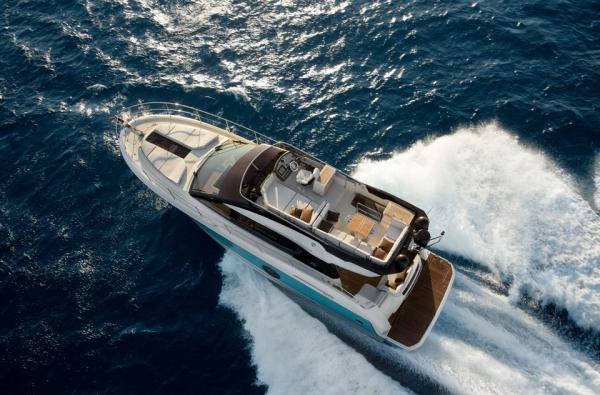
What do you do when your parent company has successfully launched four different powerboat lines? Well, if you’re Monte Carlo Yachts (MCY), a subsidiary of Group Beneteau, you launch a fifth one that is nothing like the others.
Carla Demaria is the brains behind Monte Carlo Yachts, a boatbuilder that was developed to bring Italian style and larger motoryachts into the parent business’ stable. Once MCY established itself with flybridge models like the 65 and 70, Demaria became the head of both Monte Carlo Yachts and Beneteau Power. She soon discovered the full potential of an in-development series called MC. It’s a midsize yacht line that bridges the gap between the existing Monte Carlo Yachts and Beneteau-branded powerboats. Her goal became finalizing the yacht’s modified, deep-V hull form, bringing in some Italian flair and creating a new cruiser concept. And the first one is a 49-footer called the MC5.
It’s worth looking at that hull design that started the MC line. It’s basically a V-shaped hull that transitions to a 12-degree transom deadrise, but the innovative part was extending and deepening the V as it runs forward. At the bow, it joins the stem at a near right angle instead of the normal rounded forefoot. This produces the fashionable vertical stem at the bow, but conventional wisdom suggests that such a design will not handle well in a following sea because the bow will dig in. I wondered how the Volvo Penta IPS-driven MC5 would perform in the prevailing spirited seas.
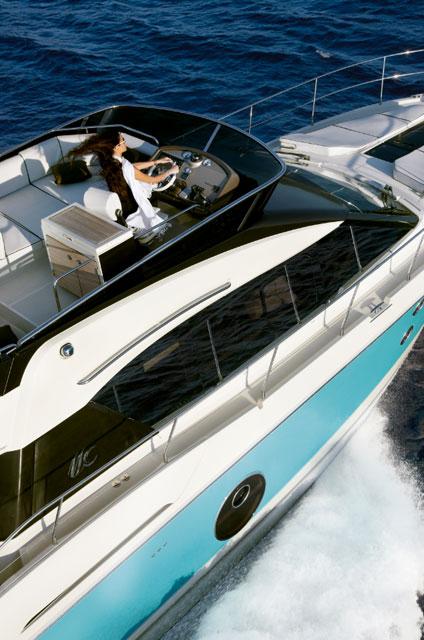
The conditions off Cannes, France, featured wind-generated waves from the east and a considerable legacy swell coming in from the southwest, creating confused and challenging 3- to 6-foot seas. Running into the waves before we encountered the swell, the MC5 behaved impeccably, slicing and dicing. The hull lifted onto plane with little change in trim, and the ride was dry and well under control with little slamming from the chines because of the extended fine entry.
The challenge came in the following seas when the legacy swell was the dominant wave pattern. I was concerned that the bow would dig into the waves. While I ran the MC5 at 20 knots with the big swell on the quarter, probably the worst conditions for a vessel with this hull form, the steering took a bit more wheel to keep on course, but there was no cause for alarm. With the IPS, I was steering with propeller thrust, and this worked well when combined with the excellent directional stability of the hull. Overall, it was a solid, stable ride.
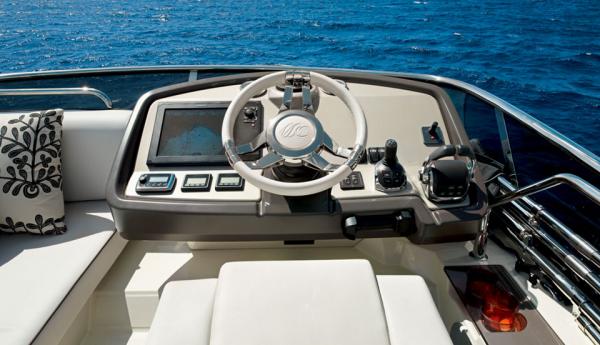
At all times the boat felt composed, and I realized that underneath the eye-catching styling there was a sound and sensible hull design. The MC5’s top speed was just a shade faster than 28 knots, and, as expected, the control in the following seas improved as the speed was increased. As per usual with IPS drives, low-speed maneuverability was precise, especially with the optional joystick control.
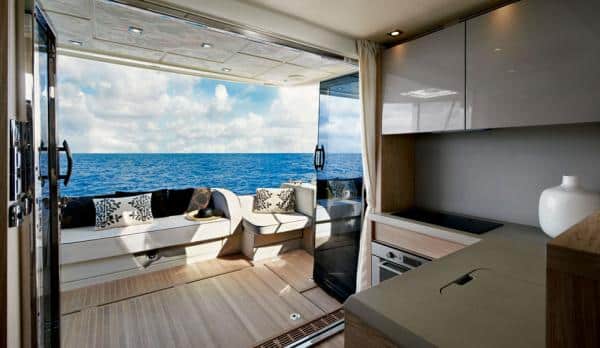
My test vessel’s twin 435 hp Volvo Penta IPS600 diesels and IPS drives are fitted in an engine compartment that is spacious and accessible, even with an aft crew cabin, which is accessed through a hatch built into the cockpit’s transom settee. If you don’t want the cabin here, the space serves as a lazarette. There is no garage because tender stowage is on the high-low swim platform.
As for the styling, her Italian influence is quite evident. This yacht’s pale-turquoise hull contrasted starkly with the black trim of her flybridge. Her profile is somewhat upright, emphasized by that vertical bow, but her sloping windscreen relieves this and the style grows on you. Instead of hull windows, the designers used traditional portholes with large ports, allowing generous amounts of light into the master cabin.
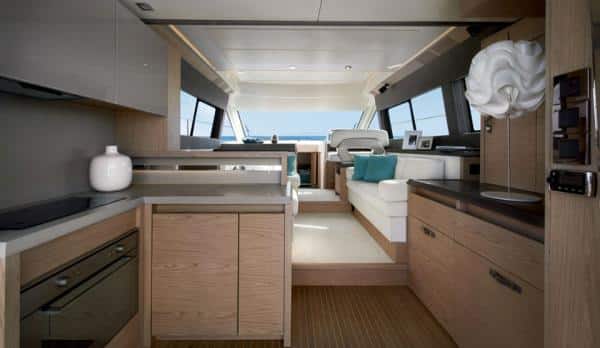
Although there is a strong styling focus, the MC5 has many practical features. For instance, the cockpit and salon are on the same level, which makes for easy movement about the boat and adds to the feeling of openness. Handholds are plentiful for secure movement about the boat, and the side decks are wide enough for you to walk up to the foredeck in comfort. With the galley located aft on the main deck, it’s readily accessible from either the cockpit or the salon. The designers have gone to great pains to hide the fact that this is a galley when it is not in use, and there are even foldaway taps at the sink.
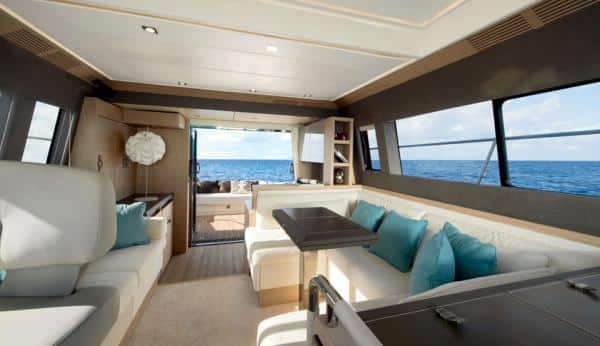
The MC5’s salon features large windows that offer great vistas even when guests are seated. A fold-out, leather-covered table can be raised or lowered, and on the port side of the forward area is a series of lockers for convenient stowage.
Her belowdecks space is not quite as abundant. The three cabins feel a bit squeezed in, a reminder that this is only a 49-footer, but they’re still comfortable. The forward VIP is particularly inviting, but most of the space is occupied by the bed. This cabin shares its head with the twin-bunk cabin abaft it and to starboard. Each bunk has its own porthole.
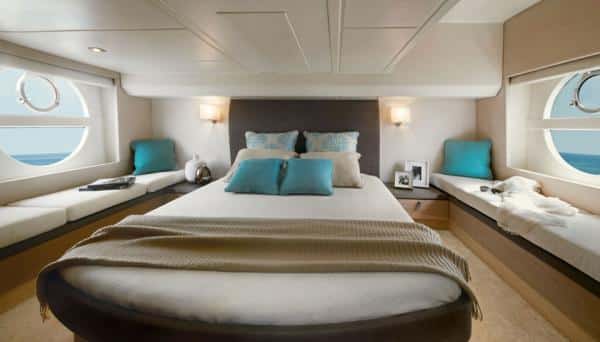
A master cabin with en suite head lies under the salon, and while there is 6-foot-6-inch headroom around the bed, it’s limited over the bed because the salon floor drops down above it. Because of the hull’s V-shape, the cabin sinks down into it and there are varying floor heights to contend with. Round hull-side windows about 3 feet in diameter are a great feature that bring in abundant natural light. Throughout this yacht’s interior, the MC5’s style quotient combines a restful mix of stained oak wood, quality fabrics and textured coverings with dark-brown leather trim.
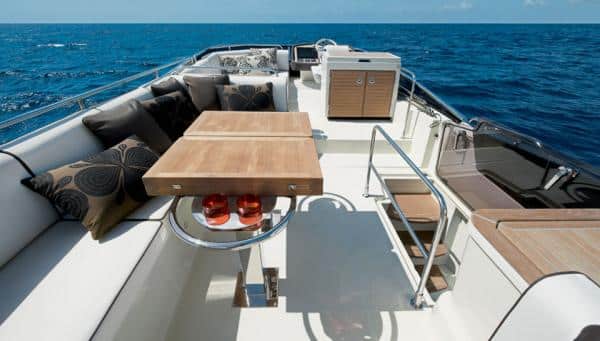
Her flybridge is huge and has all the required features for entertaining at sea, including optional barbecue counters and an icebox. At the single helm seat, there is a commanding view and room on the console for your electronics. The reverse-angle windscreen, however, does not offer a lot of protection, so you get a real feeling of the performance up here.
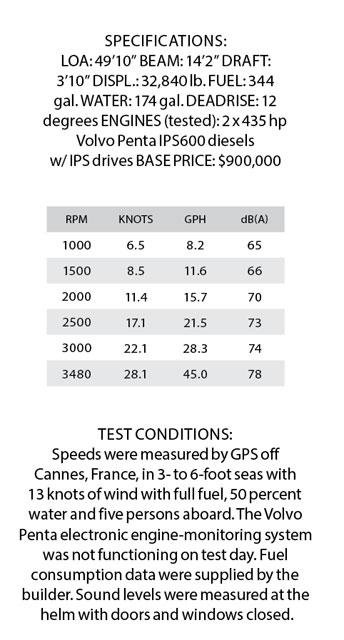
Visibility from the starboard-side lower helm is restricted from about 45 degrees to amidships, both at speed and at idle, by a composite window frame that supports the single-piece windshield. There is an opening window to the starboard side that helps. The single-lever electronic controls are easily reached and palmed by a right hand. Twin Simrad displays as well as the engine instrumentation can be seen with a quick glance.
Monte Carlo has done a great job executing this combination of style and performance, from the helm setup to the ocean-taming hull design. So often performance in lively seas takes second place, but that’s where the MC5 shines. She may be a midsize yacht, but her build, ride and style say big boat all day long.
Monte Carlo Yachts, 954-763-3971; montecarloyachts.it
This article first appeared in the December 2013 issue of Yachting.








